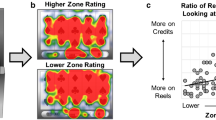Abstract
The influence of a brief mental imagery task was examined to determine if imagining engaging in gambling behaviors would satiate the participant on gambling-related reinforcers and subsequently reduce gambling behavior. Thirty-one participants underwent a mental imagery task consisting of either imagining gambling on a slot machine 30 times and placing quarters into a laundry machine 3 times, or imagining gambling on a slot machine 3 times and placing quarters in a laundry machine 30 times. Following the imagery task, participants were allowed to play a real slot machine and stop whenever they wanted to be finished. The results showed that those who imagined playing the slot machine 30 times before actually gambling played significantly fewer trials than those who imagined playing only 3 times. Clinical implications and future directions are discussed.

Similar content being viewed by others
References
American Gaming Association. (2010). 2010 State of the states: The AGA survey of casino entertainment. Retrieved May 2, 2011, from http://www.americangaming.org/assets/files/State_of_the_States_2010_FINAL.pdf.
Breen, R. B. (2004). Rapid onset of pathological gambling in machine gamblers: A replication. International Journal of Mental Health and Addiction, 2, 44–49.
Breen, R. B., & Zimmerman, M. (2002). Rapid onset of pathological gambling in machine gamblers. Journal of Gambling Studies, 18, 31–43.
Dixon, M. R., & Johnson, T. E. (2007). The gambling functional assessment (GFA): An assessment device for identification of the maintaining variables of pathological gambling. Analysis of Gambling Behavior, 1, 44–49.
Dowling, N., Smith, D., & Thomas, T. (2006). Treatment of female pathological gambling: The efficacy of a cognitive-behavioral approach. Journal of Gambling Studies, 22, 355–372.
Ferentzy, P., Skinner, W., & Antze, P. (2006). Recovery in Gamblers Anonymous. Journal of Gambling Issues, 17. Available at http://www.camh.net/egambling/issue17/pdfs/ferentzy1.pdf.
Griffiths, M. (1999). Gambling technologies: Prospects for problem gambling. Journal of Gambling Studies, 15, 265–283.
Hayes, S. C., Strosahl, K. D., & Wilson, K. G. (1999). Acceptance and commitment therapy: An experiential approach to behavior change. New York: Guilford Press.
Kantor, J. R., & Smith, N. W. (1975). The science of psychology: An interbehavioral survey. Chicago: Principia Press, Inc.
Lesieur, H. R., & Blume, S. B. (1987). The South Oaks Gambling Screen (SOGS): A new instrument for the identification of pathological gamblers. American Journal of Psychiatry, 144, 1184–1188.
McConaghy, N., Armstrong, M. S., Blaszczynski, A., & Allcock, C. (1988). Behavior completion versus stimulus control in compulsive gambling: Implications for behavioral assessment. Behavior Modification, 12, 371–384.
Morewedge, C. K., Eun Huh, Y., & Vosgerau, J. (2010). Thought for food: Imagined consumption reduces actual consumption. Science, 330, 1530–1533.
Petry, N. M. (2005). Gamblers Anonymous and cognitive-behavioural therapies for pathological gamblers. Journal of Gambling Studies, 21, 27–33.
Skinner, B. F. (1974). About behaviorism. New York: Knopf, Inc.
Stewart, R. M., & Brown, R. I. (1988). An outcome study of gamblers anonymous. The British Journal of Psychiatry, 152, 284–288.
Stinchfield, R., & Winters, K. C. (2001). Outcome of Minnesota’s gambling treatment programs. Journal of Gambling Studies, 17, 217–245.
Welte, J. W., Barnes, G. M., Wieczorek, W. F., Tidwell, M., & Parker, J. (2002). Gambling participation in the U.S.- results from a national survey. Journal of Gambling Studies, 18, 313–337.
Author information
Authors and Affiliations
Corresponding author
Rights and permissions
About this article
Cite this article
Whiting, S.W., Dixon, M.R. Effects of Mental Imagery on Gambling Behavior. J Gambl Stud 29, 525–534 (2013). https://doi.org/10.1007/s10899-012-9314-0
Published:
Issue Date:
DOI: https://doi.org/10.1007/s10899-012-9314-0




